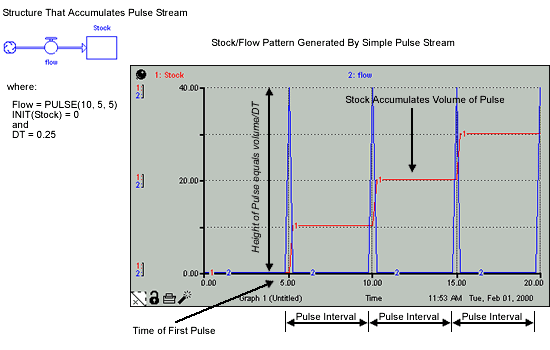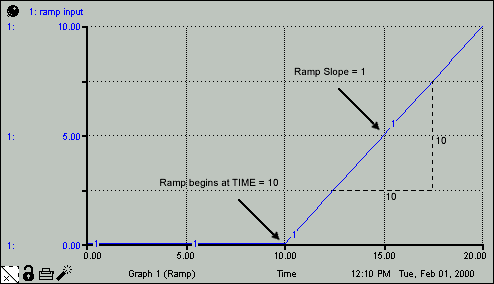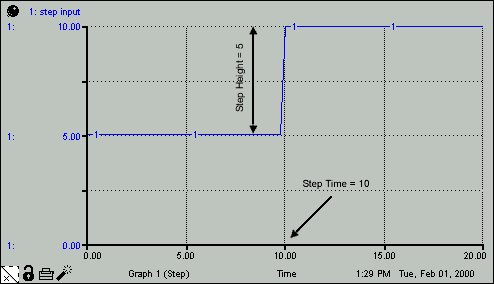
The test input builtins enable you to conduct controlled experiments on your model. Typically, a PULSE, RAMP, or STEP is appended to an inflow or outflow equation. When the builtin is activated (at the time you specify), it will knock the system out of its previous state. You can then observe how your model responds to this idealized test.
Conducting controlled experiments using idealized inputs such as PULSE, RAMP, and STEP is an excellent way to build understanding of the inner workings of your model.
This section describes the following builtins:
The PULSE builtin generates a pulse input of a specified size (volume). When using the PULSE builtin, you have the option of setting the time at which the PULSE will first fire (first pulse), as well as the interval between subsequent PULSEs. Each time that it fires a pulse, the software pulses the specified volume over a period of one time step (DT). Thus, the instantaneous value taken on by the PULSE builtin is volume/DT. Volume can be either a variable or a constant. Specify the first pulse and interval values as constants.
If you don't provide a value for first pulse, the software generates the first pulse at the outset of your simulation run and continues to use it. This form is intended for situations where you have a quantity of material you want to put into a stock. If you don't provide an interval, the software generates subsequent pulses each DT of the model simulation (that is to say always). Setting interval to 0 yields a single pulse that doesn't repeat; it's the equivalent of specifying an interval that's greater than the length of the simulation.
Example:
The following figure shows the structure, equations, and behavior pattern for a simple PULSE stream that accumulates in a stock.

The RAMP builtin generates a linearly increasing or decreasing input over time, with a specified slope. Optionally, you may set the start_time at which the ramp begins, and the end_time at which the ramp stops. The slope and time values can be either expressions or constants.
As the simulation progresses, RAMP returns a 0 before its time to begin has been reached. If you don't set RAMP's time, it will begin at the outset of the simulation.
Example:
Ramp_Input = RAMP(1,10) generates the pattern shown in the following figure.

The STEP builtin generates a one-time step change of specified height, which occurs at a specified time. The height and time values can be either variables or constants.
Example:
Step_Input = 5 + STEP(5,10) generates the behavior pattern shown in the following figure.
